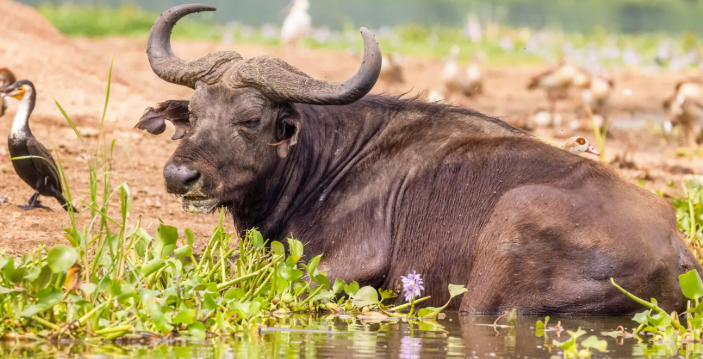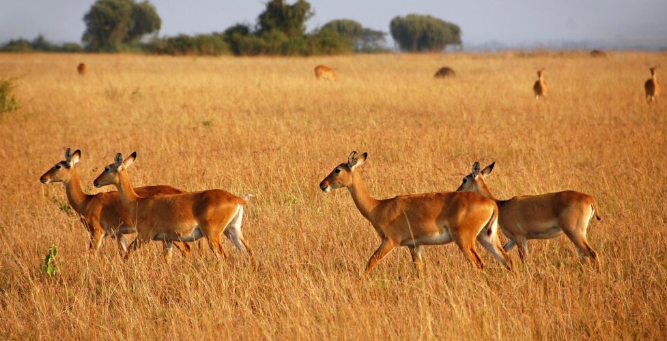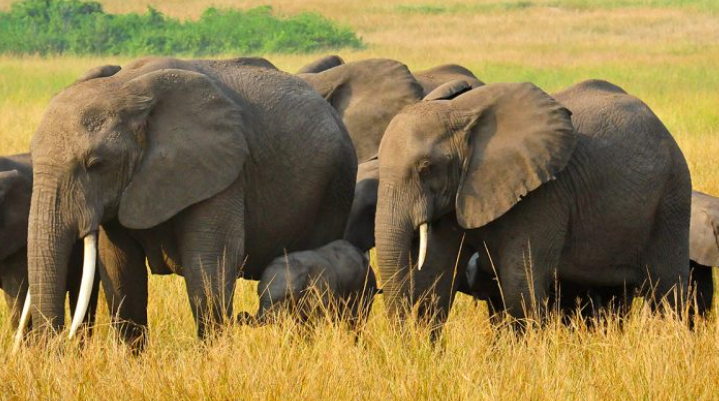Queen Elizabeth National Park

Located in Uganda’s most spectacular wildlife sanctuary, Queen Elizabeth National Park is a haven for diverse ecosystems, incredible wildlife encounters, and unforgettable safari experiences. For those wondering where Queen Elizabeth National Park is located in Uganda, the park sits in western Uganda’s Rift Valley.
It spans across the western districts of Kasese, Kamwenge, Rubirizi, and Rukungiri, positioned along the equator between Lake Edward and Lake George. Before planning your visit, studying the Queen Elizabeth National Park Uganda Map will help you understand the park’s layout and key attractions.
Also See: Serengeti National Park
Why Queen Elizabeth National Park Should Be Your Next Safari Destination
Queen Elizabeth National Park is more than just a destination; it’s Uganda’s most popular & oldest national park; a wildlife paradise that offers some of Africa’s most unique and diverse safari experiences.
What is Queen Elizabeth National Park famous for? This remarkable park is renowned for its tree-climbing lions, the wildlife-rich Kazinga Channel, diverse ecosystems, and being one of Uganda’s most accessible wildlife destinations.
Here’s why adventurous travelers choose this remarkable park for their ultimate East African safari journey.
1. The Kazinga Channel: Africa’s Wildlife Highway
The 40-kilometer Kazinga Channel connecting Lake Edward and Lake George is the crown jewel of Queen Elizabeth National Park. This natural waterway hosts one of the world’s largest concentrations of hippos, over 4,000 of them alongside massive Nile crocodiles basking on the banks.
A boat cruise along the channel reveals elephants wading in the shallows, buffalo herds coming to drink, and countless bird species including African fish eagles, pied kingfishers, and colorful bee-eaters. The channel’s banks teem with life, making it one of Africa’s most rewarding wildlife viewing experiences.
2. Tree-Climbing Lions of Ishasha
Queen Elizabeth National Park is one of only two places in the world where you can witness the rare phenomenon of tree-climbing lions. In the remote Ishasha sector, these magnificent predators have adapted to lounging in the branches of ancient fig trees and acacia, creating extraordinary photographic opportunities.
The park is also home to leopards, spotted hyenas, and over 600 bird species, including the prehistoric-looking shoebill stork. With its diverse habitats ranging from savannah to wetlands, the park offers some of the richest wildlife viewing in East Africa.
3. Diverse Ecosystems and Stunning Landscapes
Queen Elizabeth National Park’s beauty lies in its incredible diversity of landscapes. The park encompasses sprawling savannahs dotted with euphorbias, dense tropical forests, sparkling crater lakes, and the dramatic backdrop of the Rwenzori Mountains, the legendary “Mountains of the Moon.”
The Kyambura Gorge, known as the “Valley of Apes,” cuts through the landscape like a green scar, harboring chimpanzees and other primates. Meanwhile, the Maramagambo Forest provides a mystical canopy walk experience, and the countless crater lakes reflect the sky like scattered jewels across the landscape.
4. Rich Cultural Heritage
The park’s surroundings are home to diverse communities including the Bakonzo, Banyankole, and Basongora people, each with unique traditions and customs. Visit local fishing villages along the shores of Lake Edward, experience traditional salt mining at Lake Katwe, or learn about the ancient kingdoms that once flourished in this region.
The cultural encounters add depth to your safari experience, offering insights into how local communities have coexisted with wildlife for generations while maintaining their traditional ways of life.

When to Visit Queen Elizabeth National Park
Queen Elizabeth National Park offers exceptional wildlife viewing throughout the year, but each season brings its own advantages:
June to September – This is the peak dry season, when wildlife congregates around water sources making game viewing easier. The weather is pleasant with clear skies perfect for photography, though this is also the busiest period.
December to February – The short dry season offers excellent wildlife viewing with fewer crowds. This is an ideal time for boat safaris on the Kazinga Channel and tracking the tree-climbing lions in Ishasha.
March to May and October to November – These are the rainy seasons, when the park transforms into a lush green paradise. Bird watching is at its peak, accommodation rates are lower, and you’ll enjoy a more intimate safari experience with spectacular landscapes.

Our Queen Elizabeth Safari Experiences
At Ruganos Wild Adventures, we offer carefully crafted safari experiences to suit every traveler’s preferences. When considering Queen Elizabeth National Park prices, we provide transparent pricing across different comfort levels. Explore our Queen Elizabeth Safari Price options:
Budget-Friendly Adventures
Perfect for travelers seeking Cheap Queen Elizabeth Safari Packages without sacrificing the thrill of discovery. Includes transport, park fees, meals, and guided game drives. You’ll stay in comfortable budget lodges or campsites near the park, with shared transport and daily game drives led by experienced local guides.
Mid-Range Comfort
For those who want enhanced comfort while staying connected to the wild, our mid-range safaris feature well-appointed safari lodges with en-suite facilities, Kazinga Channel boat cruises, and guided nature walks with expert rangers.
Premium Wildlife Expeditions
Designed for travelers seeking the ultimate Queen Elizabeth experience, these packages include stays in luxury safari lodges, private game drives, exclusive boat safaris, chimpanzee tracking in Kyambura Gorge, and gourmet bush dinners overlooking the savannah.

Customize Your Safari with Ruganos Wild Adventures
Queen Elizabeth National Park isn’t just a place to see wildlife it’s a destination that stirs the soul, blending breathtaking landscapes, rare animal encounters, and rich cultural heritage into one unforgettable safari experience.
At Ruganos Wild Adventures, we believe your journey should be as unique as the park itself. That’s why we offer customizable safaris designed to match your travel style, interests, and budget.
Contact Ruganos Wild Adventures and let us craft your perfect Queen Elizabeth National Park safari.
